How 3D printing enables innovative thermal management solutions
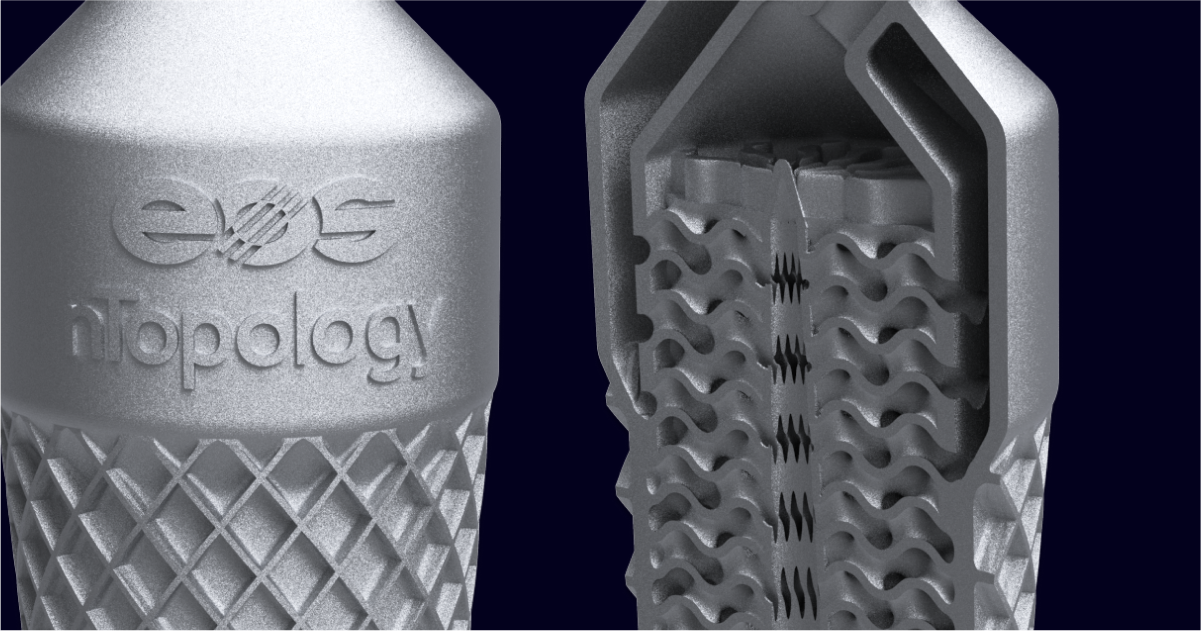
Written by nTop
Published on September 1, 2022
Effective thermal management is crucial if you design products with electrical components. Discover how 3D printing can enable you to take your thermal management efforts to the next level by creating more compact and efficient heat exchangers.
The heat generated by modern devices' power, transmission, and electronic subsystems can be significant. This means that effective thermal management is a critical design consideration for any electronic device or system. But as products become increasingly complex, thermal management is becoming more difficult.
Additive manufacturing, also known as 3D printing, represents an opportunity to level up your approach to thermal management — enabling you to create high-performance heat exchangers (HEX) that meet even the most demanding product space, weight, and manufacturability requirements.
This article will explore the impact of additive manufacturing on thermal management capabilities, the benefits of additive manufacturing in HEX design, and some examples of where additive manufacturing has been applied to facilitate optimal thermal management.
The impact of additive manufacturing on thermal management
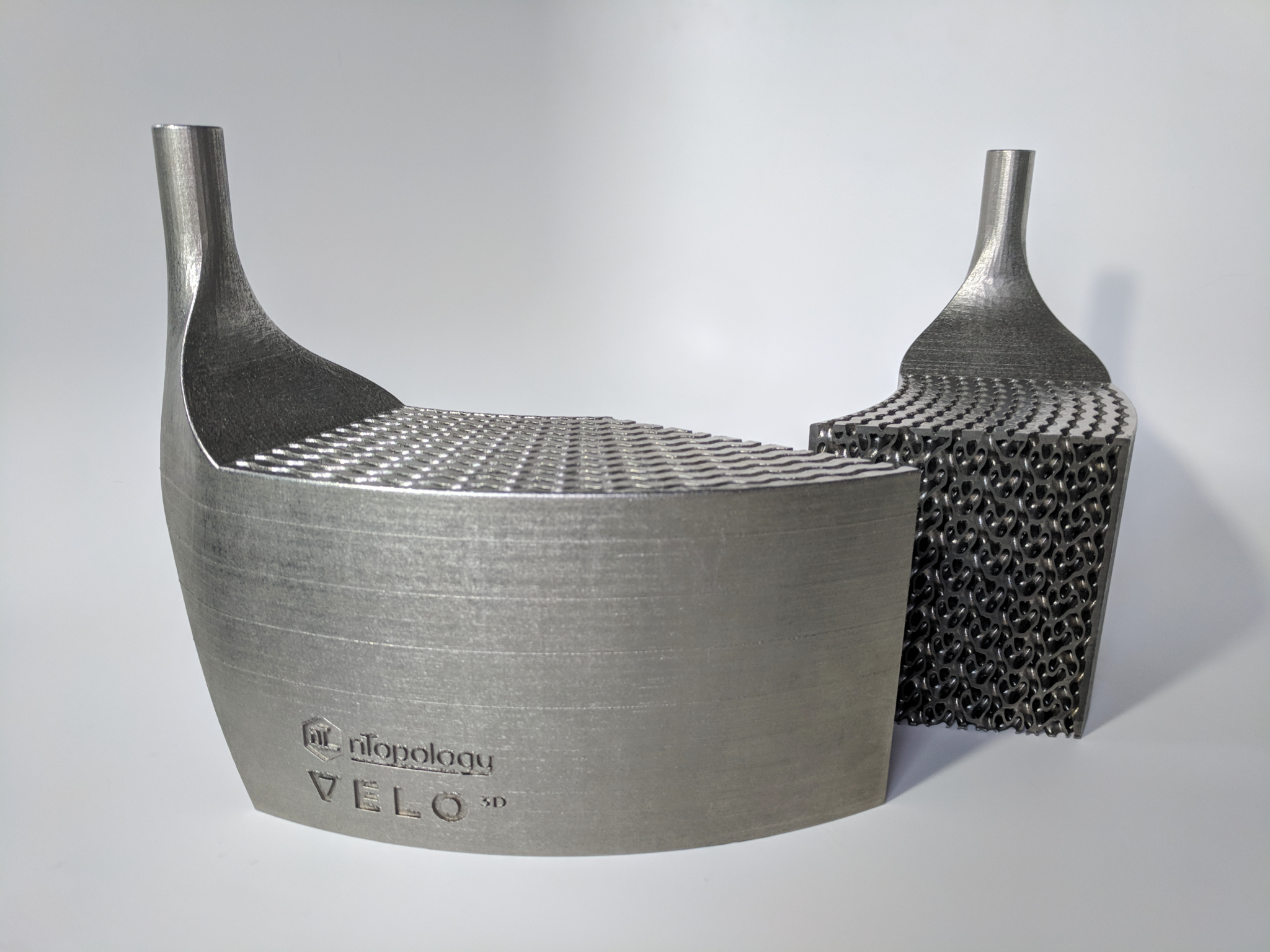
Industrial AM heat exchanger with gyroid core designed in nTop.
By dissipating excess heat from critical components, thermal management can help extend the operational lifetime of products and increase their reliability.
However, the available space for a thermal management solution is often limited. Additive manufacturing (AM) offers a pathway to achieving more efficient and compact heat exchangers (HEXs) so that you can meet space and weight requirements. This is because the design freedom associated with AM technology can enable you to create HEXs with complex internal channels and geometries that are often impossible to manufacture with traditional methods.
In short, additively manufactured HEXs can meet the specific needs of a given application, making them an ideal solution for various thermal management challenges.
Benefits of additive manufacturing in HEX design
Improved heat transfer efficiency
You can tackle heat transfer inefficiencies with AM by manufacturing complex and innovative structures. Lattice structures are popular for heat exchangers because they offer a high surface area to volume ratio. This design means that more heat transfers in a smaller overall space.
Triply Periodic Minimal Surface (TPMS) lattices, such as the gyroid, are the perfect candidate for heat exchanger design. Additive manufacturing is ideal for creating these complex and highly optimizable structures that fulfill performance, weight, size, and manufacturability requirements.
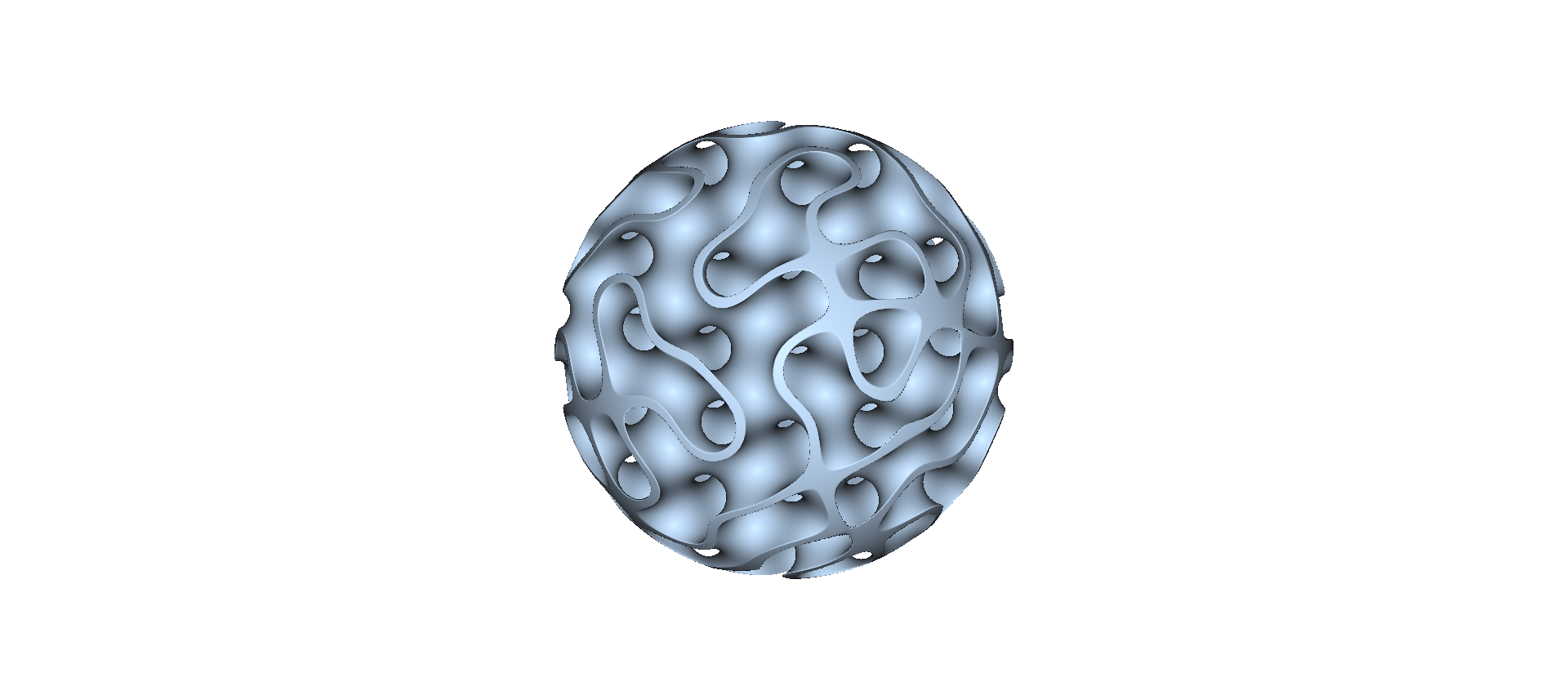
Gyroid TPMS lattice structure.
Reduced pressure drops and improve flow rate
With additive manufacturing, you can apply new shape optimization methods to meet specific performance requirements, such as flow rate or pressure drop. For example, it is possible to create inlets and outlets specifically designed to smooth fluid flow and eliminate dead zones where the flow speed is zero. This design can significantly reduce the pressure drop across the heat exchanger, making it more efficient.
Moreover, if you use CFD simulation to determine flow paths in a HEX, you can generate geometries tailored to these flow fields to create a highly optimized lattice structure. Often, these structures are impossible to manufacture with traditional processes.
Improved quality
AM enables you to manufacture the HEX in one piece, eliminating the need for forming, assembly, brazing, and welding. By consolidating the assembly into one part, you can minimize common and potential leakage or failure regions, improving your HEX design's durability and reliability. This also reduces the costs associated with inventory and labor.
Thermal management applications and 3D printing
Additive manufacturing can be applied across many different industries and applications and is fundamentally changing our approach to heat exchanger design. Below are a few examples of combining additive manufacturing and advanced engineering design software to achieve significant thermal management improvements.
Auxiliary power unit casing cooling
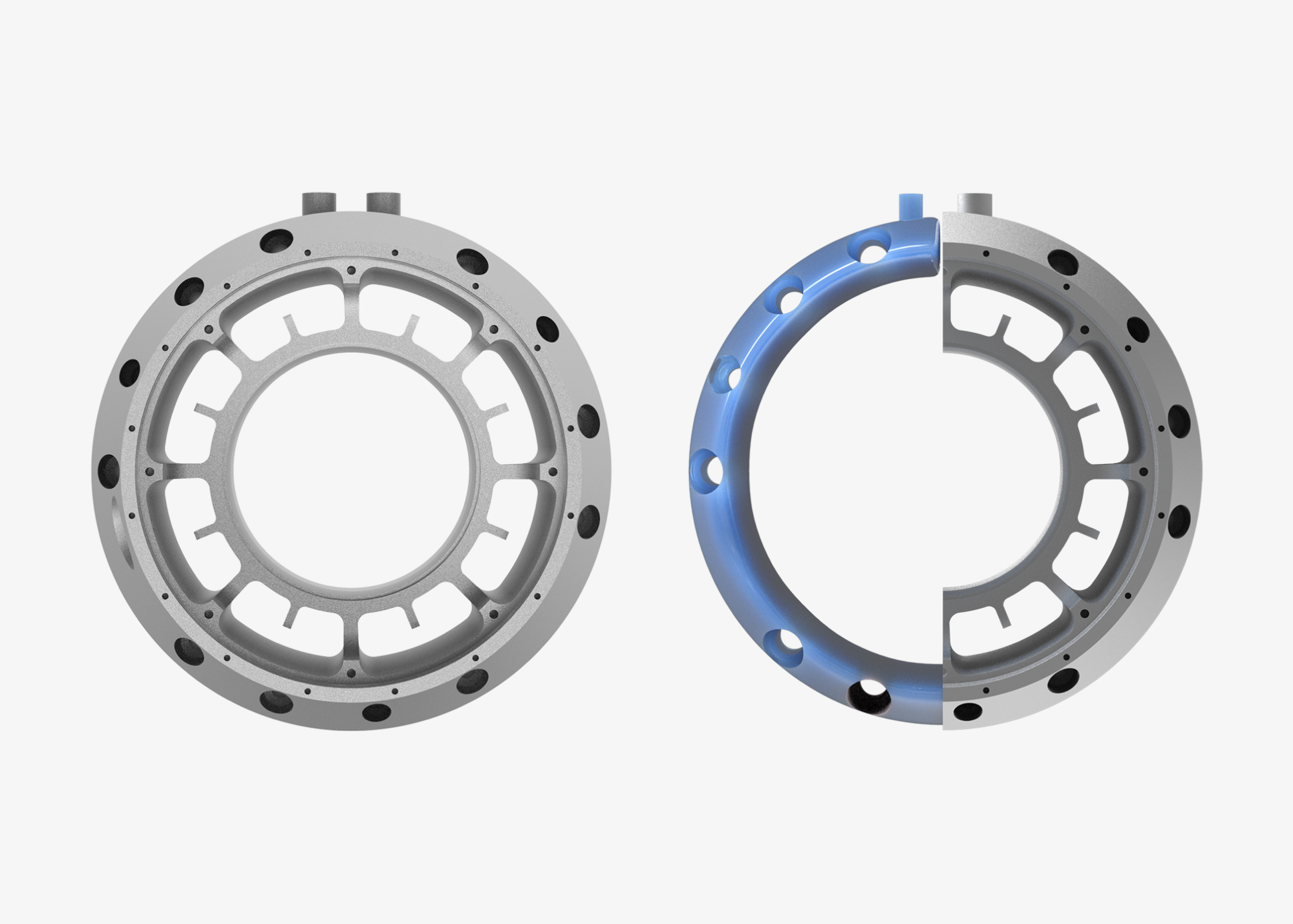
Microturbine housing with embedded cooling channels designed in nTop.
KW Micro Power develops auxiliary power units (APUs) with high power density. These units are designed for use in commercial aviation and military applications. Reducing weight while maintaining performance is crucial for applications where every gram counts, such as in aircraft or drones.
When KW Micro Power set out to redesign the housing of their aerospace-grade, high-power-density, compact turbogenerator for metal additive manufacturing, the main goal was to improve thermal performance while maintaining quality and safety.
Redesigning the part for 3D printing opened new opportunities for the KW Micro Power team, enabling them to convert the empty shell into a conformal cooling channel. This significantly improved the thermal management of their generator.
The resulting design was a multifunctional and lightweight part featuring conformal channels that reduced the maximum operating temperature by 33% and the weight by 44%. These results extended the lifespan of the machine and the system’s overall efficiency.
Fuel-cooled oil coolers

An aerospace-grade fuel-cooled oil cooler designed in nTop.
The oil cooler is crucial in many engines, particularly those used in industrial processing or power generation rigs. Its primary purpose is to cool the engine oil, which helps to protect the engine from overheating and ensures optimal performance. However, miniaturized or mobile systems often can’t accommodate traditional shell and tube oil coolers because they are too large or heavy.
In these cases, an additively manufactured heat exchanger with a gyroid TPMS core can pose a solution. The engineers of the fuel-cooled oil cooler pictured above replaced the legacy shell, and tube HEX with a 3D printed alternative with a gyroid TMPS core, using a new additive aluminum alloy developed by HRL Laboratories. The primary aim of this solution was to reduce the size and mass of the cooler while keeping the heat transfer area constant.
To achieve this aim, the team leveraged nTop’s advanced software and ANSYS suite for fluid and conjugate heat transfer simulation, which enabled them to design a high-performance heat exchanger that was 80% lighter.
Despite this weight reduction, the resulting design had an overall heat transfer coefficient higher by almost an order of magnitude per unit mass. This new design passed all ASTM quality standards.
Cold plates
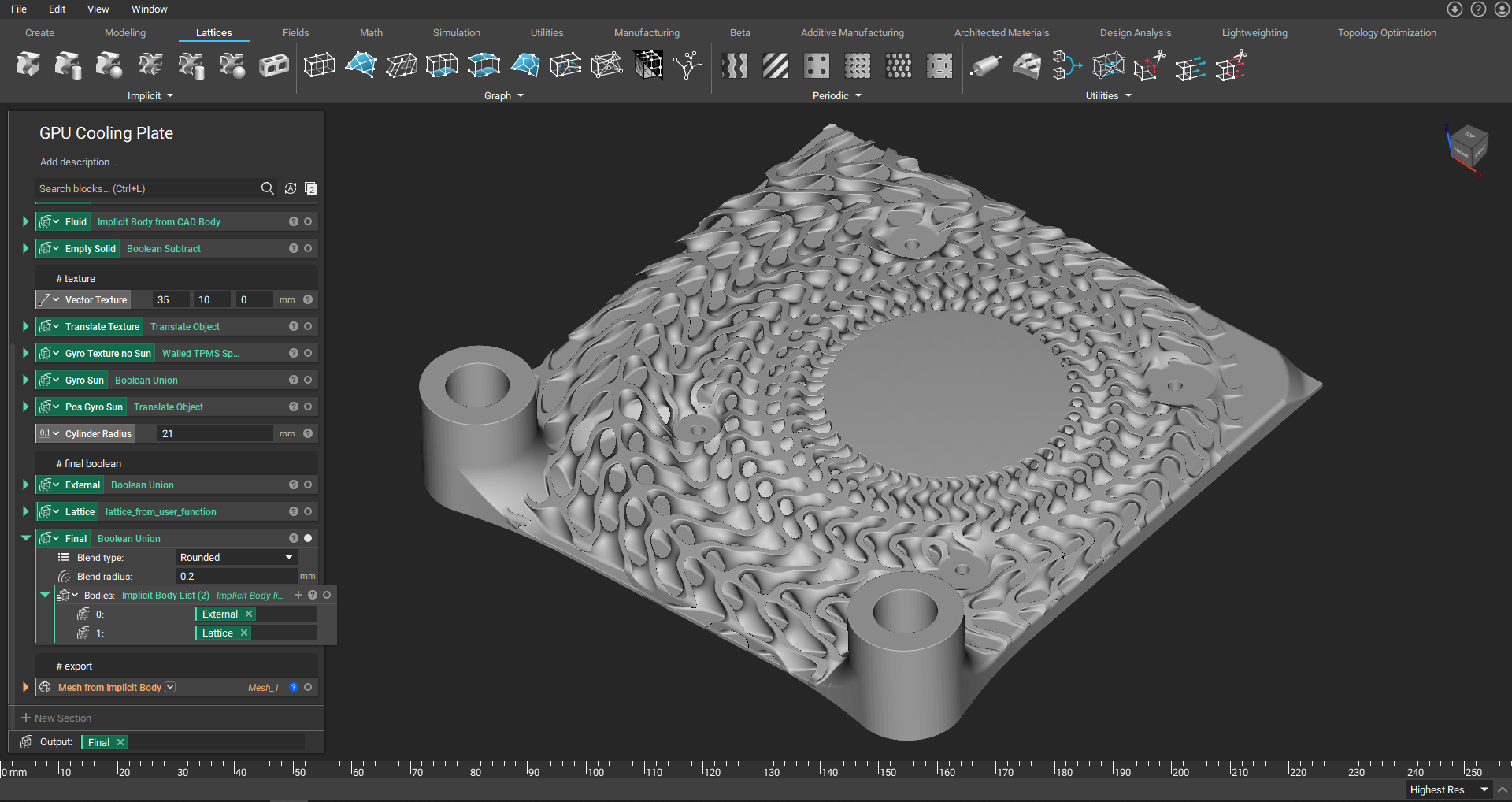
GPU cooling plate designed in nTop.
There are many ways to improve the heat exchanger design of a cold plate using AM. One approach is to use a lattice core, which can help to increase the heat transfer coefficient without increasing the overall size. This design can be especially beneficial for cooling electronic devices, like inverters and GPUs.
Using simulation to drive the design process, you can ensure that the cold plate performs optimally. This process helps improve the device's efficiency and prevents potential issues arising from an inadequate cooling system.
The team at TEMISTh used this approach to create a compact cold plate with an improved heat transfer coefficient. They manufactured the design in aluminum and tested it under real-life conditions. The results showed that the cold plate could effectively cool the electronic components, even under heavy load.
This innovative approach to cold plate design can be used and refined to improve the performance of a wide range of electronic devices.
Software to design better heat exchangers
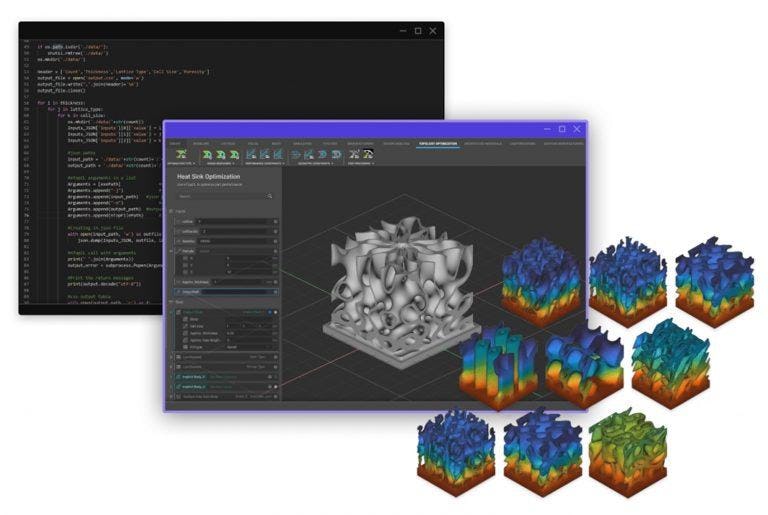
Design exploration of heat sink geometry using a systematic computational DoE approach in nTop.
You need access to advanced engineering design software to maximize the benefits of additive manufacturing for thermal management. nTop is a powerful tool revolutionizing engineering design with its implicit modeling, field-driven design, and codeless automation capabilities.
nTop’s key thermal management features include:
- Access industry-leading lattice design, scalable to billions of elements.
- Quickly gauge the thermal performance of your HEX and the surrounding components with linear, non-linear, thermal stress, and transient thermal analyses.
- Generate new design candidates, mesh and send to Discovery Live for rapid iteration or a CFD code for virtual validation.
- Slice and export machine data directly from an implicit body to bypass STL file size restrictions, or simplify mesh to tolerance or threshold, and export as STL, OBJ, or 3MF.
- Control all fillet radiuses with boolean unions and accurately calculate both mass and surface area.
- Generate flow and thermal guides from thermal maps or flow fields (e.g., field-driven pins & fins) and use virtual baffles to control flow without overly restricting it.
With nTop, you can unlock the opportunities and design freedom of additive manufacturing and create the next generation of heat exchangers for your products.
Read our thermal management guide to learn more about how additive manufacturing can support your thermal management efforts.
Key takeaways
- Thermal management is becoming more demanding as product requirements increase.
- 3D printing can help you meet size, weight, and manufacturability requirements while ensuring your heat exchanger performs according to specification.
- With the right advanced engineering design software, you can maximize the benefits of additive manufacturing to achieve optimal thermal management, even when demanding requirements need to be met.

nTop
nTop (formerly nTopology) was founded in 2015 with the belief that engineers’ ability to innovate shouldn’t be limited by their design software. Built on proprietary technologies that upend the constraints of traditional CAD software while integrating seamlessly into existing processes, nTop allows designers in every industry to create complex geometries, optimize instantaneously, and automate workflows to develop breakthrough parts and systems in record time.




